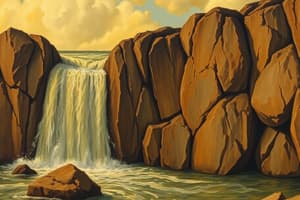Podcast
Questions and Answers
What type of stress involves forces pulling in opposite directions?
What type of stress involves forces pulling in opposite directions?
- Compressional stress
- Shear stress
- Brittle stress
- Tensional stress (correct)
Which type of deformation occurs when a material permanently changes shape and cannot return to its original shape?
Which type of deformation occurs when a material permanently changes shape and cannot return to its original shape?
- Ductile deformation (correct)
- Viscous deformation
- Brittle deformation
- Elastic deformation
What happens when stress applied to rocks exceeds their internal strength?
What happens when stress applied to rocks exceeds their internal strength?
- The rocks remain unchanged
- The rocks undergo elastic deformation
- The rocks immediately melt
- The rocks experience strain and deform (correct)
Which statement best describes brittle deformation in rocks?
Which statement best describes brittle deformation in rocks?
At which point does elastic deformation transition to ductile deformation?
At which point does elastic deformation transition to ductile deformation?
Which of the following statements about pore pressure is correct?
Which of the following statements about pore pressure is correct?
In which type of fold are the oldest rock strata located at the center of the fold?
In which type of fold are the oldest rock strata located at the center of the fold?
What is the primary characteristic of a monocline?
What is the primary characteristic of a monocline?
What does strike refer to in geological terms?
What does strike refer to in geological terms?
Which type of fold is characterized by dipping, non-vertical axial planes and limbs that dip at different angles?
Which type of fold is characterized by dipping, non-vertical axial planes and limbs that dip at different angles?
What characterizes the formation of monoclines?
What characterizes the formation of monoclines?
In which manner do normal faults displace the hanging wall in relation to the footwall?
In which manner do normal faults displace the hanging wall in relation to the footwall?
How do sedimentary basins typically form?
How do sedimentary basins typically form?
What is the primary characteristic of strike-slip faults?
What is the primary characteristic of strike-slip faults?
What distinguishes a thrust fault from a typical reverse fault?
What distinguishes a thrust fault from a typical reverse fault?
Flashcards are hidden until you start studying
Study Notes
Stress and Strain
- Strain occurs when the force exerted per unit area (stress) exceeds the internal strength of the rocks
- Three types of stress: tensional, compressional, and shear
- Tensional stress pulls rocks in opposite directions, resulting in stretching and thinning
- Compressional stress pushes rocks together, causing folding and thickening
- Shear stress involves transverse forces, resulting in blocks or regions of material moving past each other
Deformation
- Deformation can be elastic, ductile, or brittle
- Elastic deformation is reversible when stress is released
- Ductile deformation results in permanent changes, where the material doesn't revert to its original shape
- Brittle deformation is the point when rock integrity fails and fractures under increasing stress
- Factors influencing deformation: pore pressure, strain rate, rock strength, temperature, stress intensity, time, and confining pressure
Geologic Maps
- Representations of geologic formations and structures at the Earth’s surface.
- Formations are recognizable rock units
- Use symbols and colors to represent different formations, faults, folds, and inclined rock units.
- Formation labels use uppercase letters to denote the geologic time period and lowercase letters for formation name or rock description.
Cross Sections
- Subsurface interpretations made from surface and subsurface measurements
- Provide vertical views of subsurface geology
Strike and Dip
- Symbols represent inclined beds
- Strike is the horizontal line along the inclined layer
- Dip is the angle a bed plunges into the Earth from the horizontal
- Measured using a compass and expressed as an angle from true north
Folds
- Curved or bent layers of rock formed by ductile deformation
- Commonly formed by compressional forces at depth
- Described by their orientation of axes, axial planes, and limbs
- Types of folds:
- Anticline: arch-like, convex-upward, oldest rocks in the center
- Syncline: trough-like, concave-upward, youngest rocks in the center
- Monocline: step-like, flat rocks upwarped or downwarped
- Dome: symmetrical upwarping, inverted bowl shape
- Basin: bowl-shaped depression
Faults
- Brittle deformation where two blocks of rocks move relative to one another
- Normal and reverse faults display vertical (dip-slip) motion
- Footwall is below the fault plane, hanging wall is above the fault plane
- Faulting refers to rupture of rocks, often occurring at plate boundaries
Normal Faults
- Hanging wall moves downward relative to the footwall
- Created by tensional forces
- Common at divergent plate boundaries
- Examples: Wasatch Fault, Hurricane Fault
- Grabens, horsts, and half-grabens are blocks of crust or rock bounded by normal faults.
Reverse Faults
- Compressional forces cause the hanging wall to move up relative to the footwall
- Thrust faults are reverse faults with a low dip angle
- Megathrust faults are a special type of reverse fault at subduction zones
Strike-Slip Faults
- Side-to-side motion
- Most common at transform plate boundaries
- Sinistral motion: opposing block moves left
- Dextral motion: opposing block moves right
- Examples: San Andreas Fault (dextral), Dead Sea fault (sinistral)
Earthquakes
- Energy released by blocks of rock sliding past each other
- Most occur along active plate boundaries
- Elastic rebound theory explains the release of seismic energy.
- Focus (hypocenter) is the initial point of rupture
- Epicenter is the location on the Earth’s surface vertically above the focus
How Earthquakes Happen
- Fault blocks are locked together by friction
- Stress builds up until it overcomes frictional resistance, causing rupture
- Rocks snap back toward their original shape (elastic rebound)
- Fault creep is continuous, gradual displacement between fault blocks
- Foreshocks can occur before a large earthquake
- Aftershocks follow the mainshock
Seismic Waves
- Carry energy through the Earth
- Wave amplitude, wavelength, frequency, and period determine magnitude and intensity of earthquakes
- Constructive interference amplifies waves
- Destructive interference diminishes wave amplitudes
Seismic Waves
- Seismic waves are the physical manifestation of energy released by fault block movement.
- Seismic waves are categorized as either body waves or surface waves.
- Body waves travel through the Earth's interior.
- Body waves comprise P waves and S waves.
- P waves are the fastest body waves and travel through solids, liquids, gases, and plasma.
- S waves travel slower than P waves and only travel through solids.
- Surface waves are generated by body waves reaching the Earth's surface.
- Surface waves consist of Raleigh waves and Love waves.
- Surface waves are slower than body waves and cause the most damage during an earthquake.
- Love waves cause horizontal ground shaking.
- Raleigh waves cause elliptical ground motion.
- All seismic waves can refract and reflect when passing through rock with varying density.
- S waves are blocked by the Earth's liquid outer core, creating an S wave shadow zone on the side of the planet opposite the earthquake focus.
- The Earth's liquid outer core refracts P waves, creating a cone-shaped P wave shadow zone.
Induced Seismicity
- Induced seismicity is caused by human activity near natural gas extraction sites.
- The injection of waste fluids during fracking increases pore pressure within rock.
- Increased pore pressure lowers frictional forces holding rock together, lubricating fault planes.
- This lubrication leads to earthquakes near injection sites.
- The surge in drilling activity in the central US has caused a significant increase in induced seismicity.
Measuring Earthquakes
- Seismographs are used to measure ground vibrations.
- Early seismographs used a weighted pen (pendulum) suspended by a spring above a recording device.
- Modern digital seismographs use magnets, coils, sensors, and digital signals.
- Seismograph arrays have multiple seismographs to measure vibrations in three directions (north-south, east-west, up-down).
- The difference in arrival times of P, S, and surface waves can be used to pinpoint the location of an earthquake epicenter.
- Triangulation using seismographs from three or more stations can determine the epicenter.
- The International Registry of Seismograph Stations lists over 20,000 seismographs worldwide.
- The Global Seismic Network, with over 150 stations, electronically distributes real-time data.
- The USArray comprises hundreds of permanent and transportable seismographs to map earthquake activity in the US.
- The Global Seismic Network also helps monitor nuclear weapons testing.
Seismic Tomography
- Seismic tomography uses seismic rays from earthquakes passing at different angles through rock to create 3D images of Earth’s interior structures.
- Seismic velocity is dependent on rock density and elasticity.
- Cooler rocks have a higher density and transmit waves faster.
- Warmer rocks have a lower density and transmit waves slower.
- Seismic anomalies are differences between the expected and actual arrival times of seismic waves at seismic stations.
- By analyzing seismic anomalies, geologists can create 3D images of Earth’s interior.
Earthquake Magnitude and Intensity
- Magnitude measures the energy released by an earthquake.
- The Richter Scale (ML) is logarithmic, with each unit representing a 10-fold increase in seismic wave amplitude and 32 times more energy released.
- Moment magnitude (MW) is more accurate for measuring larger earthquakes and uses information from multiple locations.
- The Modified Mercalli Intensity Scale (MMI) is a qualitative rating of ground shaking based on damage and perception.
- Intensity maps show the level of shaking damage.
- ShakeMaps use real-time seismographic data to show areas of intense shaking.
Earthquake Risk
- Earthquake magnitude, location, direction, local geologic conditions, and focus depth affect shaking intensity.
- The type of building materials, intensity and duration of shaking, resonance, and structural integrity influence earthquake destruction.
- Seismic gaps are periods of inactivity on a fault with a history of earthquakes, indicating potential strain buildup and higher probability of an earthquake.
- Earthquake trenches help geologists estimate the frequency of past earthquakes.
Earthquake Distribution
- Earthquakes are concentrated around tectonic plate boundaries, except for intraplate earthquakes.
- Subduction zones at convergent boundaries produce the largest and deepest earthquakes (megathrust earthquakes).
- Collision zones between converging continental plates cause deep, large earthquakes.
- Transform boundaries create strike-slip faults that generate moderate to large earthquakes.
- Divergent boundaries produce moderate earthquakes.
- Intraplate earthquakes, less common, occur in areas of weakened crust or concentrated tectonic stress.
Secondary Earthquake Hazards
- Ground shaking and fault block displacement are the primary causes of earthquake damage.
- Secondary hazards, such as tsunamis, landslides, and fires, can occur after the shaking stops.
Earthquake Hazards
- Liquefaction occurs when water-saturated sediments become fluid-like due to shaking, causing buildings to settle or tilt.
- Tsunamis are earthquake-induced ocean waves caused by seafloor displacement, growing in amplitude as they approach shore.
- Landslides can be triggered by shaking. The 1992 Utah earthquake caused a landslide destroying structures.
- Seiches are waves generated in lakes by earthquakes, causing water to slosh back and forth or change lake depth.
- Land elevation changes can occur due to fault movement, resulting in subsidence or upheaval.
Case Studies
- Basin and Range earthquakes: Occur in normal faults due to tensional forces, like the Wasatch Fault in Utah.
- New Madrid earthquakes (1811-1812): Large earthquakes in Missouri causing significant damage and river course changes due to intraplate seismic activity.
- Charleston (1886): Magnitude 7.0 earthquake caused significant ground motion and liquefaction, likely associated with ancient faults.
- Great San Francisco earthquake and fire (1906): Magnitude 7.8 earthquake along the San Andreas Fault caused widespread destruction and fires.
- Alaska (1964): Magnitude 9.2 earthquake along the Aleutian subduction zone, causing land subsidence and uplift.
- Loma Prieta (1989): Magnitude 6.9 earthquake on the San Andreas Fault caused deaths, freeway damage, and bridge collapse.
- Shaanxi, China (1556): Magnitude 8 earthquake killed approximately 830,000 people, the deadliest in history, due to cave dwelling collapse.
- Lisbon, Portugal (1755): Magnitude 8–9 earthquake and subsequent tsunami killed thousands.
- Valdivia, Chile (1960): The most powerful earthquake ever recorded (magnitude 9.4–9.6), lasting 10 minutes, triggered tsunamis and volcanic eruptions.
- Tangshan, China (1976): Magnitude 7.8 earthquake caused widespread destruction and a high death toll due to unreinforced buildings.
- Sumatra, Indonesia (2004): Magnitude 9.0–9.3 earthquake triggered massive tsunamis, causing widespread devastation.
- Haiti (2010): Magnitude 7 earthquake caused significant damage and contributed to a cholera outbreak, resulting in a high death toll.
- Tōhoku, Japan (2011): Magnitude 9.0 earthquake triggered a devastating tsunami, leading to high casualties and damage, including nuclear power plant meltdown.
Studying That Suits You
Use AI to generate personalized quizzes and flashcards to suit your learning preferences.




